Let there be light, and there I was – wobble

Image courtesy of Luke with Pixnio by way of a Creative Commons license. https://pixnio.com/objects/electronics-devices/electric-lights-pictures/fluorescent-lights
This morning I became angry.
For TWO YEARS I have tolerated relative darkness in my kitchen, all because the overhead flourescents had grown dim. They needed changing. The replacement lights had been sitting on a cabinet in the dining room. For TWO YEARS.
Why, you ask, didn’t I change them?
Because I’m old and wobbly. I was afraid to climb up on the stool.
I was afraid I’d fall.
Falling is no big deal when you’re 28. You get up and keep going.
But falling when you’re 68 is a major, possibly life-altering deal. You could end up in Beal Memorial.
So I put up with the weird, gray twilight that existed in my kitchen – for TWO YEARS – until this morning, when I glanced at those replacement lights lying on the cabinet in the dining room. They pissed me off. I pissed me off.
“You’re going to change those damn lights,” I told myself.
I fished the folding step-stool from beside the refrigerator, set it up under the fixture and undogged the latches that held the cover in place.
Wobble – wobble – wobble. I held onto the microwave, the cabinet, just anything I could grab.
Wobble – wobble – wobble. I got the old light tubes out. The fixture was different than any flourescent light socket I’d ever seen. The prongs just popped into the slots – there was no rotating.
Wobble – wobble – wobble. I put the new tubes in, and let me tell you it was touch and go. Once, I had to quickly jump off the stool, as I was about to fall.
Wobble – wobble – wobble. I got them in, climbed down from the stool, uttered a silent prayer and flicked the light switch.
Voila! I now have light in the kitchen – for the first time in TWO YEARS.
That’s one of the things they never tell you about getting old – the impossibility (or in this case improbability) of doing things you once did with ease. Never in a thousand years would I have expected to fear climbing a two-step stool to change a light.
But I got the job done, and there won’t be a next time. According to the packaging, the new tubes are expected to last 44 years.
Oh, and Nielsen sent me a $5 bill for completing their ratings survey.
Wobble – wobble – wobble. A pretty good day so far.
Next up – the roof!
About the author:
Del Stone Jr. is a professional fiction writer. He is known primarily for his work in the contemporary dark fiction field, but has also published science fiction and contemporary fantasy. Stone’s stories, poetry and scripts have appeared in publications such as Amazing Stories, Eldritch Tales, and Bantam-Spectra’s Full Spectrum. His short fiction has been published in The Year’s Best Horror Stories XXII; Alfred Hitchcock’s Mystery Magazine; the Pocket Books anthology More Phobias; the Barnes & Noble anthologies 100 Wicked Little Witch Stories, Horrors! 365 Scary Stories, and 100 Astounding Little Alien Stories; the HWA anthology Psychos; and other short fiction venues, like Blood Muse, Live Without a Net, Zombiesque and Sex Macabre. Stone’s comic book debut was in the Clive Barker series of books, Hellraiser, published by Marvel/Epic and reprinted in The Best of Hellraiser anthology. He has also published stories in Penthouse Comix, and worked with artist Dave Dorman on many projects, including the illustrated novella “Roadkill,” a short story for the Andrew Vachss anthology Underground from Dark Horse, an ashcan titled “December” for Hero Illustrated, and several of Dorman’s Wasted Lands novellas and comics, such as Rail from Image and “The Uninvited.” Stone’s novel, Dead Heat, won the 1996 International Horror Guild’s award for best first novel and was a runner-up for the Bram Stoker Award. Stone has also been a finalist for the IHG award for short fiction, the British Fantasy Award for best novella, and a semifinalist for the Nebula and Writers of the Future awards. His stories have appeared in anthologies that have won the Bram Stoker Award and the World Fantasy Award. Two of his works were optioned for film, the novella “Black Tide” and short story “Crisis Line.”
Stone recently retired after a 41-year career in journalism. He won numerous awards for his work, and in 1986 was named Florida’s best columnist in his circulation division by the Florida Society of Newspaper Editors. In 2001 he received an honorable mention from the National Lesbian and Gay Journalists Association for his essay “When Freedom of Speech Ends” and in 2003 he was voted Best of the Best in the category of columnists by Emerald Coast Magazine. He participated in book signings and awareness campaigns, and was a guest on local television and radio programs.
As an addendum, Stone is single, kills tomatoes and morning glories with ruthless efficiency, once tied the stem of a cocktail cherry in a knot with his tongue, and carries a permanent scar on his chest after having been shot with a paintball gun. He’s in his 60s as of this writing but doesn’t look a day over 94.
Contact Del at [email protected]. He is also on Facebook, twitter, Pinterest, tumblr, TikTok, Ello and Instagram. Visit his website at delstonejr.com .
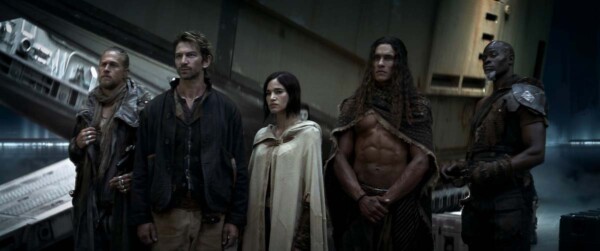
Image courtesy of Netflix.
Starring Sofia Boutella as Kora, Michiel Huisman as Gunnar, Bae Doona as Nemesis, Charlie Hunnam as Kai, Ed Skrein as Atticus Noble and others. Directed by Zack Snyder. Two hours, 13 minutes. Rated PG-13. Streaming on Netflix.
Plot summary: A quiet agrarian village on a fertile moon in a galaxy far, far away is forced to provide a Motherworld dreadnaught grain that it can’t spare. One of the villagers, the first to recognize the threat and the only one with balls though a female, scours the system for a motley crew of warriors who’ll fight the dreadnaught and its vicious commander to protect the hamlet. Part One collects the heroes who’ll resist the evil admiral and his tyrant boss.
Are there spoilers in this review: Not really.
—
Mladen’s take
What can I say about “Rebel Moon” other than it’s an OK film. I didn’t even bother watching it using my home theater.
I thought “Rebel Moon” was rated R. It wasn’t, so the violence is tame, albeit flashy, and there’s almost no cussing. No nudity, either. Shit, the film lacks grit.
The characters aren’t all that charismatic, either. Our heroine is anguished because of who she was and what she did way back when. Her train of misfits are characters we’ve all seen in the past, including the prototypical Asian as ninja.
In short, “Rebel Moon” speeds through character development so that all we’re left with are outlines of personas. There’s the displaced prince, a spiritually wounded mother, a drunken former general, and an insurrectionist who had gone soft returning to the fight against un‑motherly Motherworld.
I’m also tired of hearing the same old voices as droids. In this case, it’s Anthony Hopkins as the latent military bot J-whatever. I listen to the bot talk and all I’m thinking is that’s the king of Asgard.
Because Del is an every-cloud-has-a-silver-lining kinda guy, I’ll honor his frail tendency to try to balance good and bad by noting a couple of the film’s bright spots.
“Rebel Moon” production value is top notch. The film offers very good world building. The CGI is clean, as clean as the meld of real and fake in last year’s “The Creator.” The real people in the movie look like they are a part of the planet, moon, spaceship, city, or field they find themselves in. The creatures depicted in the movie are stylish and one smacks of Greek mythology. The other prominent critter is, oh, “Lord of the Rings-y” and good enough.
I concede that there was a scene or two that absorbed me. I was eager to see how they’d end. Unfortunately, the movie would then return to its mostly uninteresting plot. Dang, sorry about that Del. I inserted a bit of negativity into my silver lining section.
“Rebel Moon” just isn’t that good. And, it just isn’t that bad.
You want to see a very good space opera? Give Star Wars “Rogue One” a spin. Clearly, it was the inspiration, if not outright template, for “Rebel Moon.” Also better alternatives to “Rebel Moon” are “Serenity,” the 2009 “Star Trek” movie, and the new “Dune.”
Will I see “Rebel Moon: Part Two – The Scargiver?” Sure. Do I care that I must wait until the movie’s April 2024 release? Not one bit. That fact, all by itself, demonstrates my enthusiasm for the “Rebel Moon” storyline.

Del’s take
Mladen, there’s no need to be positive on my behalf. “Rebel Moon” was awful. And to think: They spent $166 million making that crap? One hundred and sixty-six million would just about cover my homeowner’s insurance and property taxes here in the “free state of Florida.”
Give me a break.
“Rebel Moon” is Star Wars Lite, if such a thing is possible. When I saw director Snyder’s remake of “Dawn of the Dead” I told myself, “Now here’s a guy who knows how to make a movie.” Unfortunately, Snyder is a guy who knows how to make one movie. “Rebel Moon” looks just like “Sucker Punch,” “300” and “Watchmen,” and despite the lofty ambitions, it’s surprisingly bereft of depth.
Let’s not even talk about things like tropes or archetypes – “Rebel Moon” is a bad copy of a bad copy, like that photocopy of the mysterious night shift worker’s ass that turned up on the Xerox machine one morning and now everybody’s passing it around the office.
Dialogue is, well, corny. And not just corny corny, but fanboy at the science fiction convention Dungeons & Dragons icebreaker corny. Characterization is practically non-existent – you’ve seen these people in dozens of movies over the years, starting with Akira Kurosawa’s “The Seven Samurai,” the same place Snyder got the plot. It would have been hilarious if he’d ripped off J.J. Abrams. Alas, the universe doesn’t have that ironic a sense of humor. FX are not great, either. I should think $166 million would buy you a more realistic-looking spaceship or future city.
It’s all a gussied-up, overhyped pile of same-old, same-old, and I’ll be honest – it actually offends me. The science fiction genre – at least the printed-on-paper part of the genre – has thousands of really terrific stories waiting to be told. Why waste $166 million on this retread?
Part 2 is coming and I could care less. I know how it’s going to end. I’ve already seen it. I don’t need to waste my time watching part 2 of a movie that scored 23 percent on Rotten Tomatoes.
Mladen’s grade: C (C- if, for a moment, the sci-fi tropes irritate me)
Del’s grade: D
Mladen Rudman is a former journalist and technical writer. Del Stone Jr. is a former journalist and writer.

Image courtesy of Toho Studios.
Starring Minami Hamabe as Noriko Oishi; Ryunosuke Kamiki as whiny Koichi Shikishima; Sakura Ando as Sumiko Ota; Kuranosuke Sasaki as Quint, ah, Yoji Akitsu; Munetaka Aoki as Sosaku Tachibana; Hidetaka Yoshioka as Hooper, ah, Kenji Noda; and a toddler who cried as needed, among others. Directed by Takashi Yamazaki. Rated PG-13. Two hours, 4 minutes in length. Theatrical release.
Mladen’s take
“Godzilla Minus One” ain’t no “Shin Godzilla” but it’ll do. My concern is that Toho Studio’s new filmmaking philosophy is to render Godzilla movies more people-centric, rather than monster-focused, to draw more theatergoers and yen. How do I know? Because “Godzilla Minus One,” which is a crappy title for the movie, by the way, has trounced all of its other Godzilla releases at the Japanese and global box offices.
I concede that I almost fell into Toho’s people matter trap, which Del, no doubt, willingly threw himself into. Hamabe’s Noriko and Ando’s Sumiko are terrific in the film and, well, stunning, as in pretty as heck. Their presence almost offset our hero’s whimpering demeanor. All I could think about when Kamiki’s PTSD-ed former Zero fighter pilot Shikishima was on the screen was how much he reminded me of self-loathing, angst-ridden, crybaby Shinji in the “Evangelion” franchise.
“G -1.0” is a reboot of the reboot (“Shin Godzilla,” 2016) of 1954’s “Gojira.” Where “Shin Godzilla” was an innovative and imaginative rework of the heralded kaiju, “G -1.0” is a true-blue re-tell of “Gojira” down to scenes like the attack on a commuter train and a structure used by radio reporters describing Godzilla’s rampage toppling. Oh, the film’s ending is wanky, albeit intriguing.
Am I a disappointed Godzilla fanboy? No. “G -1.0” is a very good movie. When the monster appears, the action is fabulous, though derivative. Shades of “Jaws” and even the MonsterVerse’s “Godzilla vs Kong” flow through “G -1.0.” But, oh, boy, the battle between the newest Godzilla and former Imperial Japanese Navy heavy cruiser Takao is something to behold. The ship’s fate is a combination of HMS Hood, USS Arizona, and IJN aircraft carrier Akagi exploding. That scene, when I play it again and again on my home theater using a 4K disc, will be so loud that my neighbor’s will call the PD to file noise complaints. Just you wait.
Most importantly, “G -1.0” pays tribute to Akira Ifukube’s iconic Gojira score, as well as director Ishiro Honda’s vision of the monster. Hell, Tokyo’s Shinagawa ward is featured but, regrettably, there’s nary a Serizawa in the film. Still, there’s no question that you’re watching the real Godzilla, Toho’s Godzilla, rather than the non-real Godzilla, which is now that rambunctious, no-charisma, no-lineage creature of the MonsterVerse.
Yeah, go see “Godzilla Minus One” at the theater. Make sure it’s a Dolby or IMAX venue because this movie demands a sound system like no other. You Godzilla amateurs will love the people story in the film and you fanboys will get just enough G to look forward to Toho’s next release. My hope for, I don’t know, “Godzilla Plus One,” is that Toho mimics a sci-fi kaiju movie that takes its cue from Jordan Peele’s “Nope,” also somewhat of a dumb name for a film. “Nope” achieved a right smart balance between captivating humans and a fresh, big-ass monster. But it can’t be interpreted as a movie about people with the kaiju playing a supporting role.

Del’s take
“Godzilla Minus One” isn’t your grandfather’s Godzilla.
Critics and moviegoers are raving about Toho Studio’s latest iteration of the iconic lizard. Rotten Tomatoes gives it a 4.8 out of 5 rating, Simon Abrams of RogerEbert.com calls it a “well-calibrated popcorn movie,” and The Guardian says it’s one of the very best of the Godzilla series, giving it 5 out of 6 stars.
High praise indeed. So why was I so bored?
Which isn’t to say “Godzilla Minus One” is a crappy movie. It’s quite good, and Mladen, proving once again that even a blind squirrel can sometimes find a nut, rightly encourages moviegoers to see it in a theater, preferably an IMAX, to make better use of its sprawling 2.39: 1 aspect ratio. Oh, and don’t forget the Dolby surround sound.
And kudos to Toho Studios for trying to address the human quotient in its Godzilla equation, which in the past was relegated to comical stereotypes that served no purpose than to lecture the audience about whatever denunciation-worthy subject was trending at the time of filming. Don’t listen to Mladen’s crabbing about people-centric vs. monster-focused – he was long ago absorbed by an alien pod and no longer possesses human emotions.
Sure, the movie’s about a giant monster that flattens part of Tokyo. But it’s about a lot of other things, too – for instance, national identity, and the role of bushido, the honor code, in postwar Japan. The movie’s protagonist, Koichi Shikishima (played by Ryunosuke Kamiki) is a World War II kamikaze pilot who chickened out, which makes him a disgrace to himself and a traitor to his people. He lands his plane on Odo Island, where he’s exposed as a coward by members of the garrison stationed there. Later, he fails to act in a crisis and several men are killed, and his status as coward is cemented. He spends the rest of the movie trying to atone for that sin.
“Godzilla Minus One” is surprisingly candid in addressing issues of postwar sentiment in Japan vs. prewar militancy and honor, which steered me away from my traditional interpretation of Godzilla as a metaphor for the hubris of science, specifically the development of the atomic bomb. It occurred to me (maybe wrongly) that the monster could be a symbol of the United States itself, a behemoth that descends on a moral, honorable Japan and wreaks destruction without regard to who or what was deserving of such treatment.
But the movie has its problems. The first act is excruciatingly slowed by character development – not even interesting character development. I found myself propping my head on my hand, awaiting the arrival of monster mayhem. And it may be a backhanded compliment to suggest “Godzilla Minus One” is the least ridiculous of the Godzilla films but still has its moments. For instance, when the movie tries to explain the absence of America in the fight against Godzilla, it suggests the United States is fearful of a Soviet response. Apparently the scriptwriters never heard of Korea or Vietnam.
The Godzilla in this movie is an angry, muscular Godzilla, shrugging off the slow evolution that has taken place since 1954 when the monster first appeared as a symbol of Hiroshima and Nagasaki, to more recent times as Godzilla became a kind of benevolent protector from kaiju thuggery. FX are top-notch and the destruction is worthy of a Roland Emmerich film. I loved Godzilla’s radioactive breath, which set off spectacular, nuclear-like explosions. Very cool!
Also, I was impressed with Naoki Sato’s score, a perfectly calibrated synthesis of wonder and horror as the monster wreaks havoc on Tokyo’s Ginza. Yet it made room for elements of Akira Ifukube’s original “Gojira” theme, offered as a deserved homage.
Overall I’d give “Godzilla Minus One” a grade of A-. It’s an attempt to modernize the monster mythos while honoring its roots. Apart from a slow first act and a few sillies thrown in – what would a Godzilla movie be without a few sillies – it’s a good monster movie.
Mladen Rudman is a former journalist and technical writer. Del Stone Jr. is a former journalist and writer.

All images courtesy of Del Stone Jr.
It was my first real vacation in 24 years.
I’d sneaked in weekends here and there – three days in backwoods Louisiana, where the kudzu is thicker than the Cajun accents, or a weekend of schmoozing at a writers’ convention in Central Florida – but for the first time since my father passed away in 1998 I was leaving the homestead for a week to relax with friends.
The location was a small town called Blue Ridge in northern Georgia, just a white lightning run from the Tennessee border. My friends Richard, Joy and Sarah retired there after a work journey took them from Fort Walton Beach to Virginia, Alabama, and Colorado. I had visited them in Virginia and Alabama – Virginia was my favorite; sorry, Alabama – and now the attraction of mountains, and a home-cooked Thanksgiving dinner, was too much to resist.
I was surprised by the amount of crap I felt I had to take with me – my pill organizer with my vitamins and prescriptions; the waist band I wear when I exercise; my pricey enamel-restoring toothpaste. When packing for the trip I promised myself I’d bring only the essentials. Funny how so much stuff has become “essential.”
I worried I’d become drowsy during the hours of monotonous driving on the interstate, but the opposite proved to be true. It had been so long since I’d dealt with finicky cruise controls, near suicidal drivers, inexplicable interstate backups, believing I could make it to the next rest stop before my bladder erupted like Mount St. Helen, and the terror of surviving traffic in a major, and I mean major, metropolitan area like Atlanta, that I remained in a constant state of high alert.

Atlanta taught me that indeed, I am growing older, because in the past I considered the hair-raising driving practices of many Atlantans to be merely irritating. Now, they scared the hell out of me. Bumper-to-bumper at 80 mph? Had I wandered into the Daytona 500? Was I winning?
Also, I managed to get lost and instead of taking the I-575 bypass around the innards of that crazed town I ended up in something called an “express lane,” which means I will now be receiving a ticket in the mail from the Georgia Department of Transportation because I don’t have the special Peachy Keen Pass required to drive on that road. So thank you, Atlanta, for further eroding my meager checking account.
Another driving terror awaited when I reached Richard and Joy’s neighborhood. I shouldn’t call it a “neighborhood” – it’s actually a beautifully laid-out development on the side of a mountain. Gorgeous houses are spaced about 300 yards apart on very steep inclines. Trees and underbrush have been preserved, unlike developments in Florida, where the land is graded down to the earth’s mantel and then trees from Mars are planted to replace the native trees felled by the bulldozer’s blade. Life in Blue Ridge is like living in a treehouse.
The problem lies in reaching those gorgeous houses. The road was a narrow two-lane with very steep inclines and stomach-wrenching declines, with practically no road shoulder and near cliffs approaching the edge of the asphalt – at least that’s what it looked like to this Florida flatlander who lives an average of 12 feet above sea level.
Oh, and another thing. It was cold. Of course it was cold. I was 400 miles farther north than my usual stomping grounds.

And because you’re in the mountains, you’re also in the low layers of clouds, which meant it was often drippy and wet. It rained the first two days I was there and remained cloudy and damp the rest of the time. But then, when I came back home it rained like hell down here, too, so maybe it’s just me. Maybe I attract rain, like PigPen in the Peanuts comic strip attracted dirt.
Blue Ridge appears to be a favored vacation spot for Floridians. I’d say a quarter of the license plates “hailed” from the Sunshine State, if a license plate can hail. That explains the crazed drivers, at least the ones not displaying Cobb County plates.
The Cliff Notes version?
1. Packed too much crap.
2. Big city drivers – scary.
3. Cold – bad.
4. Mountains – also scary.
I hope to get back there in the spring, when I won’t look like such a freak wearing shorts. Spring should be gorgeous. Summer, too. And because you’re in the mountains, it’s cooler. And fall, with all the leaf colors.
Now that I think about it, I chose the one season of the year when maybe it wasn’t so great to visit. I need to get back up there and see what the place really looks like.
About the author:
Del Stone Jr. is a professional fiction writer. He is known primarily for his work in the contemporary dark fiction field, but has also published science fiction and contemporary fantasy. Stone’s stories, poetry and scripts have appeared in publications such as Amazing Stories, Eldritch Tales, and Bantam-Spectra’s Full Spectrum. His short fiction has been published in The Year’s Best Horror Stories XXII; Alfred Hitchcock’s Mystery Magazine; the Pocket Books anthology More Phobias; the Barnes & Noble anthologies 100 Wicked Little Witch Stories, Horrors! 365 Scary Stories, and 100 Astounding Little Alien Stories; the HWA anthology Psychos; and other short fiction venues, like Blood Muse, Live Without a Net, Zombiesque and Sex Macabre. Stone’s comic book debut was in the Clive Barker series of books, Hellraiser, published by Marvel/Epic and reprinted in The Best of Hellraiser anthology. He has also published stories in Penthouse Comix, and worked with artist Dave Dorman on many projects, including the illustrated novella “Roadkill,” a short story for the Andrew Vachss anthology Underground from Dark Horse, an ashcan titled “December” for Hero Illustrated, and several of Dorman’s Wasted Lands novellas and comics, such as Rail from Image and “The Uninvited.” Stone’s novel, Dead Heat, won the 1996 International Horror Guild’s award for best first novel and was a runner-up for the Bram Stoker Award. Stone has also been a finalist for the IHG award for short fiction, the British Fantasy Award for best novella, and a semifinalist for the Nebula and Writers of the Future awards. His stories have appeared in anthologies that have won the Bram Stoker Award and the World Fantasy Award. Two of his works were optioned for film, the novella “Black Tide” and short story “Crisis Line.”
Stone recently retired after a 41-year career in journalism. He won numerous awards for his work, and in 1986 was named Florida’s best columnist in his circulation division by the Florida Society of Newspaper Editors. In 2001 he received an honorable mention from the National Lesbian and Gay Journalists Association for his essay “When Freedom of Speech Ends” and in 2003 he was voted Best of the Best in the category of columnists by Emerald Coast Magazine. He participated in book signings and awareness campaigns, and was a guest on local television and radio programs.
As an addendum, Stone is single, kills tomatoes and morning glories with ruthless efficiency, once tied the stem of a cocktail cherry in a knot with his tongue, and carries a permanent scar on his chest after having been shot with a paintball gun. He’s in his 60s as of this writing but doesn’t look a day over 94.
Contact Del at [email protected]. He is also on Facebook, twitter, Pinterest, tumblr, TikTok, Ello and Instagram. Visit his website at delstonejr.com .
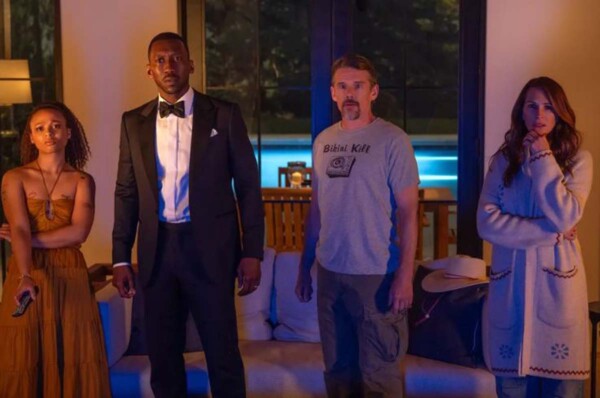
Image courtesy of Netflix.
“Leave the World Behind” Starring Julia Roberts as Amanda Sandford, Mahershala Ali as G.H. Scott, Ethan Hawke as Clay Sandford and Myha’la as Ruth Scott. Directed by Sam Esmail. Two hours, 18 minutes. Rated R. Streaming on Netflix.
Del’s take
Early on in “Leave the World Behind,” Amanda Sandford (Julia Roberts) mutters, “I fucking hate people.” Well congratulations, Amanda. The people haven’t let you down.
On this side of the silver screen MAGAdiots are flocking to Google and trashing “Leave the World Behind” with one-star reviews. Their outrage is so dim they can’t even write their own reviews – they’ve copied a template over and over again, rearranging a sentence here, deleting a sentence there, it’s all the same review – which means 99 percent of them haven’t even seen the movie.
Why are they doing this?
Because “Leave the World Behind” was produced by Barack and Michelle Obama, and God forbid the Obamas do anything (not including stripping for a men’s magazine or trying to overthrow the government) without the MAGAdiots going on the attack.
Sounds like a movie I could get behind, right? Well, no, not exactly. It isn’t worthy of one star but “Leave the World Behind” is a strangely unsatisfying condemnation of the witless tragedy overtaking America today.
First, the required plot summary … or I could be a sadistic ass and leave it for Mladen. Nah. It’s Christmas, Theo. It’s the time for miracles. I’ll do it myself.
Amanda, Clay Sandford (played by Ethan Hawke) and their two annoying teenaged children, the perpetually horny Archie (Charlie Evans) and the shrill, selfish Rose (Farrah Mackenzie), escape from New York for a weekend away from the dispiriting press of those fucking people Amanda hates. They flee to an ultra modern, high-tech Airbnb in the woods, which mysteriously becomes Ground Zero for a herd of noble-but-angry-looking deer.
While luxing at this secluded mansion the Sandfords slowly become aware of an “event” that has taken place in the outside world. An oil tanker runs aground at their private beach. The TV produces nothing but snow, and the internet has stopped working, much to the annoyance of young Rose, who’s been binging on “Friends” and lacks only the final episode to complete this chapter in the decomposition of her young brain.
That night, an African American couple knocks on the door, G.H. Scott (Mahershala Ali) and his daughter Ruth (Myha’la). As it happens Mr. Scott is the owner of their rented uber-tech nest and, incredibly, wants to impose on their weekend to take shelter from a blackout that has affected the city. What ensues, then, is an ugly revealing of the nasty qualities that afflict 21st century America.
“Leave the World Behind” is an examination of the claustrophobia and xenophobia of nesting gone wrong. Amanda’s distrust of the Scotts, and her disbelief that they could even own the Airbnb, illustrates white America’s innate and, dare I say, racist perception of black people. In another scene, Clay Sandford leaves a Latino woman – who is clearly in distress – by the side of the road because he can’t understand what she’s saying and doesn’t want to get involved – refrains of “Build a wall!” Ruth’s inherent hostility toward white people guarantee tense relations between her and Amanda, and all four of the adults flirt with at least the fringes of infidelity. Oh, and then there’s the deer thing: Apparently the deer are pissed off about how mankind has treated nature.
In other words, all kinds of shit is going down the proverbial crapper, all of it at the same time. “Leave the World Behind” is a who’s who and what’s what about the wrongness of America, which left me feeling empty because it never provides a clear description of what exactly is happening – beyond vague references to a cyberattack – and never gives a hint of a solution, or at least a resolution. At times I felt like I was watching an extended episode of “Lost.” Call it the Damon Lindelof School of Ambiguous Storytelling.
The acting is fine – Julia Roberts is a bitch like I’ve never seen – and Ethan Hawke captures an almost George-like zeitgeist (Richard Burton in “Who’s Afraid of Virginia Woolf”) as the ever accommodating, ever-apologizing Clay. Mahershala Ali’s G.H. Scott is deferential to the point of caricature, while Ruth, she of the withering fury, is cynical in a way most Gen-Zers would decry (but in fact is true of that disaffected generation).
Sound effects are spot on. Distant gunshots, explosions, ships running aground and plane crashes – wow! But the musical soundtrack was way too loud and way too intrusive. Or maybe I’m showing my age – never forget I’m a gassy old fart.
“Leave the World Behind” is controversial and I guess if it’s your ox being gored, you’ll hate it (which means lots of one-star reviews from MAGAdiots). It’s got peccadilloes I could crab about all day, but it’s major flaw is that it tries to do too many things at once and, as a result, does none of them well.
I won’t give it a one-star review because we don’t use stars; we use grades. My grade would be a C+. If nothing else it’s a good barometer of your MAGA sympathies.
For God’s sake, don’t be one of those fucking people.
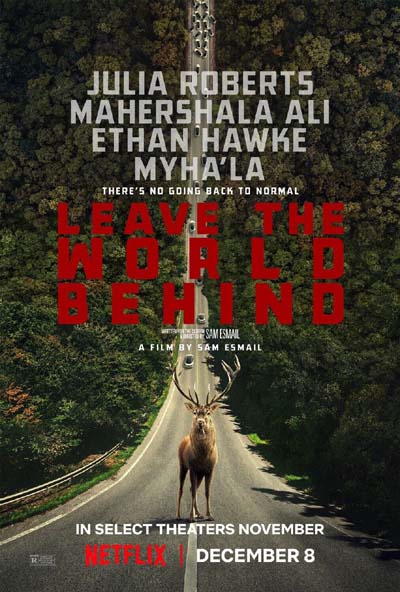
Mladen’s take
But for Del, I would be unaware that MAGAaniacs have inundated “Leave the World Behind” with template reviews. I’m amazed that ERID sycophants can read well enough to know how to use a prefabricated takedown of any movie. ERID, incidentally, is my nickname for Trump. ERID stands for Emotionally Retarded, Intellectually Disabled. An accurate description of the one-term loser poser president. No?
Del is correct and I’ll leave that statement as is without, for example, adding a disclaimer such as “for the first time ever.” “Leave the World Behind,” despite the star power, is vague, unfulfilling, and ennui laden. I hate people, too, but does that sentiment warrant a movie?
Pretty much from the beginning to the end of the film I was asking myself what’s the point. If you have 138 minutes to make the sweeping argument that Mankind, as a whole, is a heap of shit, though some of its individual components are OK, and that democracy is fragile, do it clearly. An example? Another Netflix original film, “Don’t Look Up.” Good god, what’s up with the swarming, judgmental deer or the flamingoes landing in a pool thousands of miles from their habitat? Come on, flamingoes are wading birds. They can’t swim in deep water like freaking ducks. That fact wouldn’t change no matter how their migration patterns are disrupted by inexplicable, hyper-noise that periodically filled the outdoors in “Leave the World Behind.”
I don’t know. Maybe the problem with “Leave the World Behind” is that it’s too realistic. When civilization, I use the term loosely, starts to collapse, it’s reasonable to assume many of us will fail to notice the onset of End Time. And, by the time it occurs to us that what we’ve built we’re now destroying, it’ll be too late to act. Survival will be a simple dichotomy – either you’re at the wrong place at the wrong time or you’re at the right place at the wrong time.
One more suggestion, now that I think even more fruitlessly about the film. If you watch “Leave the World Behind,” consider it inside the framework of social satire. The film ain’t no “Brazil” or “Being There,” not even close, but there’s an underlying absurdity or, oh, ridiculousness to it. The U.S. is disappearing, apparently at the misdirection of a global cabal of elites, but the teenaged boy masturbates to cell phone pictures he surreptitiously took of the almost-woman also marooned at the big, fancy house the Sanfords rented for a weekend getaway. Mrs. Sanford and Mr. Scott, the almost-woman’s father, contemplate sex, though both are married and one of the spouses, Mr. Sanford, is on the property. Yes, Big Picture trouble has arrived but people will want to screw anyway. Ain’t that darkly funny?
Should you see “Leave the World Behind?” Sincerely, I don’t care. See it. Don’t see it. As it turned out, my rationalization for seeing the movie formed after I saw it. I watched “Leave the World Behind” to demonstrate solidarity with Del. Like him, I’m troubled by ERID’s MAGAdiots.
Mladen Rudman is a former newspaper reporter and technical manuals writer. Del Stone Jr. is a former journalist and writer.

Image courtesy of Amazon MGM Studios.
“Saltburn” starring Barry Keoghan as Oliver Quick, Jacob Elrodi as Felix Catton, Rosamund Pike as Elspeth Catton, Alison Oliver as Venetia Catton, and others. Directed by Emerald Fennell. 2 hours, 13 minutes. Rated R. Streaming on Amazon Prime.
Plot summary: College freshman Oliver Quick discovers his working class roots don’t pair well with the monied elite of Oxford. He becomes obsessed with an upperclassman, the aristocratic Felix Catton, whose charm and status are qualities Oliver covets. The two become friends, and when Oliver’s father passes away Felix invites him to spend the summer at Saltburn, the family’s country manor. Once there Oliver meets the other members of Felix’s eccentric family and as the summer unfolds, Oliver is drawn deeper and deeper into their dysfunction, with unexpected and shocking consequences.
Are there spoilers in this review: Yes, numerous spoilers. Beware.
—
Mladen’s take
Del is on a tear. He’s now forced me to watch two pointless movies in a row, but the pointlessnesses are different.
“Leave the World Behind” is a vague film about the end of civilization. Del’s latest choice, “Saltburn,” is a horrifying, insouciant movie about attraction to hedonistic wealth.
Because I wasted a lot of irretrievable time watching “Saltburn,” I intend to incinerate as little of it as possible to write this review. So, Del, here’s the movie’s plot: “Saltburn” takes more than 2 hours to reveal an impossible grift. Amid those 120 minutes plus is a lot of shock-value-only imagery. The Top 3 are: Ollie slurping draining bathtub water into which Felix ejaculated; Ollie engaging Felix’s sister Venetia while she menstruated, including tasting the blood and making her taste it; and Ollie humping Felix’s newly dug grave. I have zero idea of why any of those were needed to illuminate the fact Ollie is pulling off a squalid hustle.
I should’ve watched “Saltburn” backward starting with the credits. The credits would’ve instructed me to stop watching the film immediately. How? Why? Because the movie had an “intimacy coordinator” as part of the production staff. Holy fuck. An intimacy coordinator. Is humanity getting so stupid, un-self-sufficient, unnatural, and unplugged from reality that we are unable to have sex, even pretend sex, without a coach? Blanket warning, dear reader. Never watch a film that uses an intimacy coordinator.
None of the characters, barring one, are likeable or dislikeable. They’re just gross. Gross frivolous or gross manipulative. Worse, the only person we get to see naked is Ollie. The only interesting character is Elspeth. Her naïve haughtiness often manifests as quips about human behavior. They are amusing. I also like the name. The next pet fish I buy I’m naming “Elspeth.”
“Saltburn” fails as social satire. There’s no moral. None of the soulless shits pitted against each other one way or another in this film are poor with the goal of toppling inherited wealth. This film is about a bourgie boy taking on rentiers. Everyone in the film is evil incarnate, so I never cared what happened to any of them.
“Saltburn” is banal dystopian melodrama. The setting is billionaire land under attack by a middle class college student. Who cares? I know billionaires are dicks. I know people are avaricious. I know inheritance should be outlawed. Worse, the score and soundtrack are unremarkable. Nothing radiated from the movie that I will add to my playlist.
I’m slashing a big-ass F across the screen for this movie. And, it’s not a good F, not the kind that should draw viewers because the movie is so bad it’s good. This is a straight-up shitty movie, a derelict movie, an unneeded movie like “The Human Centipede” or “Hostel.”
Del better dislike “Saltburn” wholeheartedly or I’ll sic Ollie on him.
And, yeah, I’m picking the next film to review.

Del’s take
I had to pause in my viewing of “Saltburn” to suppress a giggle. A mental image came to mind and wouldn’t go away.
When I was a kid I had a parakeet that would sit on my finger and chirp – until I ventured too close with my nose. The parakeet seemed to take this as an act of aggression – its eyes would bulge, the feathers atop its head would stand up like the inflamed strontium 90 scutes along Godzilla’s spine, and suddenly the formerly happy bird would lunge in a fit of psychotic avian rage and tear into my nostril until tears squirted from my eyes. THAT is the image – of a lunatic parakeet punishing my effrontery by surgically altering my nose – that burned into my brain as I pictured Mladen reacting to the greasy slab of undercooked kidney whale-snot pie that is “Saltburn.” It was I, after all, who suggested we review the movie. It will be I who becomes the target of Mladen’s wrath. And after the bathtub scene I expect he’ll be ready to do more harm to my face than all the parakeets in Australia.
“Saltburn” is a spectacle – a decadent, vulgar, rakish, profane, hilarious, outrageous spectacle – with no redeeming qualities or characters. But after a few minutes it is impossible not to watch, and I may end up adding it to my DVD collection, not because it is good but because it is so very, very bad.
“Saltburn” is class decadence at its best, or worst, depending on how you digest these matters. We as Americans can’t appreciate the British concept of aristocracy because we have no class. Class in America is determined by money and any clod can get his hands on money, to thereafter festoon his mansion with golden-clad penises and his book gallery with Korean schoolgirl porn. History means nothing to a country that is constantly tearing itself down and rebuilding itself,
But to a country that cherishes its history and traditions, issues of breeding, manners and class are everything, and therein lies the essential thrust of “Saltburn.” It is not just a visitation to the world of the other half. It’s a condemnation of aristocracy, yes, but more so the desire we commoners feel for those gilded, golden rules.
Young Oliver – a Dickens archetype if there ever was one – becomes whatever he must to achieve his goal of being baked into the upper crust. Along the way he loses whatever he was supposed to be in life, a fact that troubles him not a bit. He has no soul. The object of Oliver’s desire, Oxford school chum Felix, is the anti-aristocrat, an amiable guy without an ounce of self-awareness who breezes through life as the dude who’s cool without trying, the good-looking, sexy, shallow-but-not-evil rich boy who does not buy his shirts at the British equivalent of Target.
The other members of Felix’s family are also shallow, and casually cruel yet well-meaning in that self-serving way peculiar to the very rich – all except the bitchy Farleigh, who himself is trying to buttress his position within Felix’s eccentric family, his “obvious differences” notwithstanding.
Fennell gives each character a moment and the actors shine, particularly Keoghan as the pathetic and simultaneously creepy Oliver, Pike as Felix’s dingbat mother Elspeth, and Archie Madekwe as the arch cousin Farleigh.
“Saltburn” is very similar to the 1999 Matt Damon movie “The Talented Mr. Ripley” and contains several scenes guaranteed to flip the stomach from First Class to Coach. Mladen has already described them so I won’t rub your noses in the grossness. Remember: “Saltburn” is a comedy – a blackly mordant comedy, not as quiet and subtle as “Being There” or as laugh-out-loud as “Doctor Strangelove,” but yes, a comedy, masquerading as a weird, offbeat drama and stinging social commentary.
The ending felt tacked-on and tonally inconsistent with everything that preceded it. Director Fennell could have come up with a more artful way of imparting that infodump.
As I watched young Oliver make his way through the surreal countryside of the Catton family’s dreamlike world, never becoming one of them but finding his place, like a tumor on a PET scan, I wondered how it is that some people renounce the good parts of themselves to obtain a little comfort and prestige. I realized “Saltburn” does bear some relevance to “Being There,” because it proves yet again that life really is a state of mind.
I give it a grade of A-. A decadent, vulgar, rakish, profane, hilarious, outrageous spectacle – with no redeeming qualities or characters, yes. But impossible not to watch.
Mladen’s movie score: F
Del’s movie score: A-
Mladen Rudman is a former journalist and technical writer. Del Stone Jr. is a former journalist and writer.
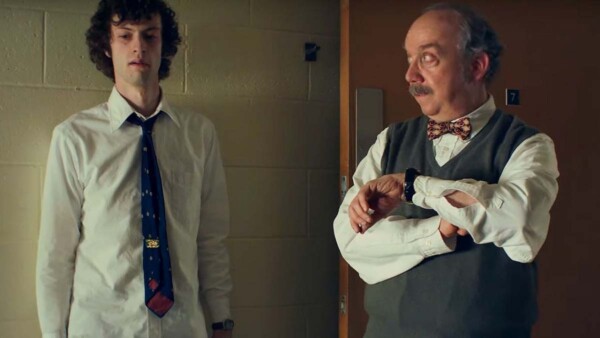
Image courtesy of Focus Features.
“The Holdovers” Starring Paul Giamatti as Paul Hunham, Da’Vine Joy Randolph as Mary Lamb, Dominic Sessa as Angus Tully, and others. Directed by Alexander Payne. Running time: 2 hours, 13 minutes. Rated R. Streaming on Peacock (free to subscribers) and for $19.99 on Apple TV, Google Play, YouTube, Vudu and Prime.
Plot summary: A crusty prep school history teacher is maneuvered into supervising a group of boys who can’t go home for Christmas. The two-week holiday break results in an unexpected dénouement for both teacher and student with life-altering results.
Are there spoilers in this review: No.
Del’s take
Every now and then a movie comes along that is so smart, cleverly written and well-acted that you can’t help being seduced by its charms. “The Holdovers” is one of those movies. It’s been nominated for five Academy Awards and if anything, that’s a couple too few. It truly is a gem.
“The Holdovers” takes place in 1970 at a stuffy New England prep school, Barton Academy, where Giamatti’s Paul Hunham has taken refuge from life. He’s disliked by students and faculty for his acid personality and relentless dedication to perfection – not even the senator’s idiot son gets any slack from Mr. Hunham.
Pitted against Mr. Hunham is the usual array of spoiled, dysfunctional rich kids, including one who shows a whiff of promise, the aquiline Angus “Anus” Tully, a tall, sharp-featured young man who’s wise beyond his years but still a kid at heart. He and Mr. Hunham become antagonists, a conflict that’s sharpened when Mr. Hunham becomes the faculty member responsible for supervising the “holdovers,” those students who can’t go home for Christmas, and Mr. Tully becomes one of those unfortunate holdovers.
Shepherding Mr. Hunham on his journey of self-discovery is the wounded Mary Lamb, played with understated sweetness and pain by Da’Vine Joy Randolph. Mary’s son, a promising Barton student himself, couldn’t escape the draft and was killed in Vietnam, a tragedy worsened by the fact he could have made it at an Ivy League school but lacked the funds – or the bone spurs – to get there.
The chemistry between Mr. Hunham, Mr. Tully and Mary Lamb becomes distilled to another level of pathos when the other holdovers are allowed to go on a ski vacation to Colorado while Mr. Tully is forced to remain at Barton because his parents are incommunicado. The three become a kind of pseudo family, with the irascible Mr. Hunham as the reluctant father who must learn to show a little humanity and cut himself some of the slack he refuses to give others, Mary as the grief-stricken mother who must rediscover joy – and her purpose – in the wake of her son’s death, and the smart-alecky Angus Tully, on the cusp of becoming a man were it not for his child-like need to be loved by his mom and his real dad. Angus is on the verge of learning that adults are also fallible and he has two excellent instructors in Mr. Humham and Mary Lamb.
Giamatti is perfect as Paul Hunham and I predict he’ll win the Oscar for best actor. Randolph brings a long-suffering grace to her role and she too may be rewarded with a best supporting actress Oscar. David Hemingson’s script imbues the story with intelligence and humor while avoiding the clichés of the Embattled Teacher genre. What surprises me is that Dominic Sessa wasn’t nominated for his role as Angus Tully, nor Alexander Payne for best director. “Barbie” wasn’t the only movie snubbed by this year’s Oscars.
I thought “The Holdovers” was a terrific movie, a rare combination of fine direction, acting and writing. It reminded me of a 1960s-vintage Simon & Garfunkle song, whip smart and catchy but at the same time human without mercy.
I’m giving it an A.

Mladen’s take
Well, at least Del didn’t throw something “Saltburn”-y at me for our next review. I fear him when he goes all let’s-watch-a-people-relationships-movie on me.
And, yes, I’m less enthused about Oscar-nominated “The Holdovers” than Del, barring Giamatti’s nuanced performance as a lonely man who transforms himself into a whole person to save the day and take a shot at chasing a dream.
Giamatti is one of Hollywood’s finest actors, an unlikely lead me who can execute any role tossed his way. Don’t believe me? Check him out as the demented and depraved and sinister enforcer in 2007’s “Shoot ’Em Up” with Clive Owen and Monica Bellucci.
Giamatti deserves the Best Actor Oscar for portraying Paul Hunham, a likeably dislikeable ancient civilizations prep high school teacher. He carried the film, though Randolph as Lamb and Sessa as Tully do decent enough jobs playing their parts. Combined, the trio captures the details of less than charmed lives with touching or funny moments like smelly Hunham using Glade as underarm deodorant, Lamb’s razor-sharp wit, and Sessa’s mischievousness and fragility.
I’m an audiophile and a sound-phile. My principal gripe with “The Holdovers” is its mopey drove-the-chevy-to-the levy soundtrack. What I wanted to hear was dynamic music coupled to depressing lyrics. Or vice-versa. Why? Because Hunham and, to lesser degree, Lamb and Tully, are complex people. A soundtrack that reflected the opposite between the music and lyrics would have enhanced the story because it, too, would have been complex and, as a result, a more realistic fit for the film. Instead, we get bleak songs set among a gray winter in New England. That’s too much misery.
My other gripe isn’t intended to downgrade the performances by Randolph and Sessa. The problem for the grieving mother and the troubled teenager is that Giamatti as the unhappy, late middle-age man is very, very good. There are brief moments in the film where Lamb and Tully seemed, I don’t know, insincere as a heartbroken mother and a wayward subadult, respectively, because Giamatti executed his role flawlessly from the beginning to the end. Giamatti is so good that even small blemishes in the acting by others stands out.
Without doubt, y’all should see “The Holdovers” despite my reasonable and accurate review. The film ends with the prospect that three wounded people whose lives intertwined for two weeks will be all right.
Look, I concede my grade for “The Holdovers” reflects bias I’m unable to shed. As Del knows, I tend toward a churned stomach watching films about fucked-up people because mankind as a genus and as individual specimens is fucked-up. It goes without saying that I exclude myself from that statement. Who cares about another movie that shows how disturbed y’all are because there are a billion films out there with the same premise?
But, “The Holdovers” is heartwarming, well-directed, well-written, well-acted, and, shit, hopeful. It illustrates the depth and character of its characters. As a recent story about damaged people, “The Holdovers” places second to 2020’s “Nomadland” and that’s saying something.
Del’s grade: A
Mladen’s grade: B
Mladen Rudman is a former newspaper reporter and technical writer. Del Stone Jr. is a former journalist and writer.
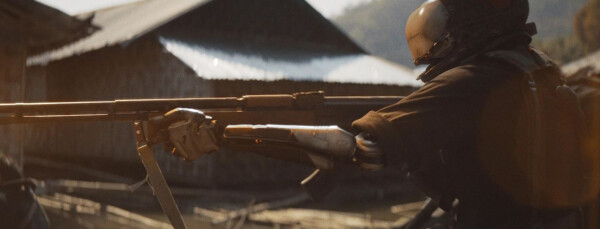
Image courtesy of 20th Century Studios.
“The Creator” stars John David Washington as Joshua, Madeleine Yuna Voyles as Alphie, Gemma Chan as Maya, Allison Janney as Colonel Howell, and Ken Watanabe as Harun. It is directed by Gareth Edwards, has a run time of 2 hours and 13 minutes, and is rated PG-13. See it in theatrical release.
Del’ take
“The Creator” did not create a box office phenomenon. In fact, it landed with a thud, earning only $30 million in its opening weekend compared to an $80 million production cost. The experts at Looper attribute its failure to the following:
The movie lacked well-known stars. John David Washington (“Tenet”) and Allison Janney (“I, Tonya”) are the two highest profile actors.
The SAG-AFTRA strike prevented the cast from promoting the film.
The film presents a sympathetic view of AI at a moment when AI technology is under fire for multiple affronts, from displacing human workers to plagiarisation and creating disinformation.
The marketing may have misled the public as to the movie’s true plot.
I would add a fifth: Meme-loving, McDonald’s-eating, Trump-voting Americans are so risk-averse they’re not willing to take a chance on an unknown entertainment quantity.
That’s a shame because “The Creator” is a decent movie. Special effects are top notch, acting is terrific, and the movie’s sweep is epic.
The plot is complicated, so bear with me: An AI entity is blamed for detonating a nuclear weapon over Los Angeles, killing millions of people and prompting the United States to undertake a pogrom to erase the algorithmic scourge from the face of the earth. A giant and impregnable space station called NOMAD orbits above a faraway land called New Asia, a haven for AI sympathizers, and blasts suspected hideouts with nuclear missiles. John David Washington’s character, a special forces dude named Joshua, infiltrates New Asia and marries the daughter of the Nirmata, or Creator, who is working to make AI even more powerful. Joshua’s mission is to identify the location of the Nirmata so that NOMAD can end the menace of AI once and for all. But Joshua’s new wife, Maya (played by Gemma Chan), is the actual Nirmata and has created a superweapon, an AI child based on her unborn baby. The child (“Alphie,” played by Madeleine Yuna Voyles), has amazing powers that could bring down NOMAD.
“The Creator” clearly has Biblical overtones and if anything, its Adam-and-Eve subtext may be too on-the-nose. It portrays AI-endowed robots as an oppressed minority who face persecution similar to that endured by Jews, African Americans and members of the LGBTQ community. The robots await the arrival of a savior who will deliver them from the persecution of Americans and the West – shades of Neo in “The Matrix.”
“The Creator’s” virtues are many. It’s a beautiful thing to look at. We saw it in IMAX and Dolby stereo, which showcased its visual and audio drama. John David Washington – who I did not know was Denzel Washington’s son! – Ken Watanabe and Allison Janney are very good in their roles. Madeleine Yuna Voyles as Alfie, the AI weapon, was excellent – this was her debut movie.
I agree with criticism the movie seems to use material from other films. At times I felt I was watching “Blade Runner,” “Platoon” or, as I said above, “The Matrix.” According to the film’s Wikipedia entry, “Edwards cited (sic) Apocalypse Now (1979), Baraka (1992), Blade Runner (1982), Akira (1988), Rain Man (1988), The Hit (1984), E.T. the Extra-Terrestrial (1982) and Paper Moon (1973) as this film’s sources of inspiration.”
“The Creator” has received generally favorable reviews from critics, who laud its spectacular special effects and grand sweep. But they simultaneously downscore it for lacking depth and heart. Said Christy Lemire on RogerEbert.com:
“Rich in atmosphere but short on substance, director and co-writer Gareth Edwards’ film has the look and tone of a serious, original work of art, but it ends up feeling empty as it recycles images and ideas from many influential predecessors.”
I’m not a Gareth Edwards fan and was unimpressed with some of his previous efforts, like “Godzilla” and “Monsters,” which I hated. But I feel I should defend “The Creator.” It’s an enjoyable science-fiction movie that at least tries to say something more than “superhero” or “Trust the Force.”
In other words, it’s not a fast-food meme, and there’s not one awful comb-over in its 133 minutes.
I give “The Creator” a B+ grade.

Mladen’s take
Strangely enough, I agree with much of Del’s “The Creator” review. The world building in this film is epic. The AI-driven simulants were fully merged with human society in New Asia. Megacities were bleak, countryside green. Cyborg and man shared everything (and it looked like it) and that produced the film’s most interesting idea, that AIs had found religion. The AIs prayed, just like humans. The AIs buried their dead or cremated them on pyres, just like humans. The AIs married each other and humans. The AIs needed a supernatural savior, just like humans.
My reaction to the notion of godliness-infused robots, which, frankly, had never occurred to me as I thought about AI? Something like this, “Holy fuck, how can beings that are supposed to be more intelligent than the critters that created them also believe there’s a ghost in the sky or a kinsman or Buddha watching over them?” My thought was all the more resonant because the only thing above New Asia with the power of Almighty was the $1 trillion space battlewagon NOMAD. Good god, God, NOMAD launched tac-nukes from an effing carousel straight down at its target, killing everything. Women, men, children, gone. Nonhuman women, men, and children, gone. Boom. Again and again. Take this and this and this, New Asia. Where are your gods when you need them most? Bah ha ha.
As Del bellyached about how little interest “The Creator” has drawn from moviegoers, I came up with an idea for a new marketing campaign. The movie is titled “The Creator,” so sell it as a creation tale extolling Creationism. “Joshua” and “Maya” are Adam and Eve because their unborn Child serves as the blueprint for a savior’s soul. What is Alphie saving? Humanity from itself. Perfect. All the world’s major monotheistic religions are dedicated to saving humans from themselves. The film’s slogan will be, “Every species needs a god.” If that doesn’t draw Del’s “meme-loving, McDonald’s-eating, Trump-voting Americans,” who also tend to be religionists, to “The Creator,” I don’t know what will.
One more thought about AIs practicing religion now that the movie has spurred me to think about it. A few weeks ago, that is before I saw “The Creator,” I developed a new definition for AI. AI does not stand for Artificial Intelligence. It stands for Apocalypse Intelligence. The AIs in “The Creator” are religionists. The “Apocalypse” is in the Book of Revelation. Duh. Of course, AI will imbibe religion. AI is already an agent of the Apocalypse, amplifying Mankind’s worst impulses and hatreds even as I write this.
One problem that Del didn’t mention is that “The Creator” is too long. Its story of undying love, redemption, hope, and the happy ending could’ve unfolded in less than 2 hours with a bit of good editing. Also, I had to keep the bile down when, amid a very cool and noisy scene featuring behemoth armored vehicles, a squad of good guys with rifles failed to hit a bad guy at near-close range. Who did the smack down? Joshua with a pistol while lying on his back protecting a wounded Alphie. God Almighty that was irritating.
But, it took no time for the film to re-envelope me with its stunning visuals after an annoying scene. This A- wonder must be seen in an IMAX or Dolby theater. The spectacle and sound are striking. I will buy it on 4K disc. I will play it at scale at home on seven speakers and a powered subwoofer but it ain’t going to be the same as the bazillion IMAX speakers and hyper-wattage that I enjoyed on a Saturday afternoon.
Mladen Rudman is a former journalist and technical writer. Del Stone Jr. is a former journalist and writer.

Image courtesy of Thoroughly Reviewed at https://thoroughlyreviewed.com/
I’ve become a cry baby in my old age.
I cry at movies – moments where the couple meet and finally – FINALLY – realize they love each other, and as the music swells, their lips come together … and my eyes get all smeary wet with tears.
Videos of soldiers coming home from deployment and surprising their kids and their spouse. I’m a sucker for those.
Especially animals that are found starving, covered in ticks, their fur matted, their tails protectively curled between their legs. Once they’ve been restored to health – and happiness – I’m grabbing the Kleenexes.
Lord, I’m a mess.
I was a crybaby when I was a kid. I remember crying at the movie “Born Free,” where Elsa the lioness returns to the Adamsons after raising a family of her own. I cried when “Old Yeller” died. And, of course, I sobbed whenever I fell off my bicycle, or the neighborhood bully gave me a bloody nose, or I shot the dove in my front yard with my pellet rifle as its mate stood nearby, confused, until I finally got too close and it flew away. I cried because for the first time I realized life was precious, and I had taken another life. These days I don’t kill much of anything except cockroaches.
I cried whenever I felt like it, until I reached my mid-teens or thereabouts. Then, something happened. I think it happens to most boys around that age.
We learn not to show our emotions. The world teaches us that. It teaches us that men who show their emotions are weak. Men who cry are babies.
Cry babies.
It’s sad, because there were many, many times during those years when I would like to have cried but didn’t, when I held my jaw in place, my lips trembling, and focused so ferociously on everything but my pain that my eyes never softened with tears.
Looking back, I wish I’d done it differently. I wish I’d cried like a baby. All it would have meant is that my heart was whole. There’s no shame in that.
I no longer believe the myth of the stiff upper lip. Strength is a virtue, yes. We all want to be strong, especially us guys. But there’s such a thing as “too strong,” where you cut yourself off from many of the feelings and emotions that make us human, and I don’t want to be strong that way. I don’t want to be a robot, or a machine. I want to live, and part of living is feeling, pain and all.
I’ll spend the remaining quarter of my life unlearning some of the things I learned in the first three-quarters, and showing my emotions is one of them. I don’t want to be the American concept of manhood.
I believe women refer to it as being “emotionally unavailable.” No thanks. I want to be emotionally available, even if it’s just to myself.
I am giving myself permission to cry.
About the author:
Del Stone Jr. is a professional fiction writer. He is known primarily for his work in the contemporary dark fiction field, but has also published science fiction and contemporary fantasy. Stone’s stories, poetry and scripts have appeared in publications such as Amazing Stories, Eldritch Tales, and Bantam-Spectra’s Full Spectrum. His short fiction has been published in The Year’s Best Horror Stories XXII; Alfred Hitchcock’s Mystery Magazine; the Pocket Books anthology More Phobias; the Barnes & Noble anthologies 100 Wicked Little Witch Stories, Horrors! 365 Scary Stories, and 100 Astounding Little Alien Stories; the HWA anthology Psychos; and other short fiction venues, like Blood Muse, Live Without a Net, Zombiesque and Sex Macabre. Stone’s comic book debut was in the Clive Barker series of books, Hellraiser, published by Marvel/Epic and reprinted in The Best of Hellraiser anthology. He has also published stories in Penthouse Comix, and worked with artist Dave Dorman on many projects, including the illustrated novella “Roadkill,” a short story for the Andrew Vachss anthology Underground from Dark Horse, an ashcan titled “December” for Hero Illustrated, and several of Dorman’s Wasted Lands novellas and comics, such as Rail from Image and “The Uninvited.” Stone’s novel, Dead Heat, won the 1996 International Horror Guild’s award for best first novel and was a runner-up for the Bram Stoker Award. Stone has also been a finalist for the IHG award for short fiction, the British Fantasy Award for best novella, and a semifinalist for the Nebula and Writers of the Future awards. His stories have appeared in anthologies that have won the Bram Stoker Award and the World Fantasy Award. Two of his works were optioned for film, the novella “Black Tide” and short story “Crisis Line.”
Stone recently retired after a 41-year career in journalism. He won numerous awards for his work, and in 1986 was named Florida’s best columnist in his circulation division by the Florida Society of Newspaper Editors. In 2001 he received an honorable mention from the National Lesbian and Gay Journalists Association for his essay “When Freedom of Speech Ends” and in 2003 he was voted Best of the Best in the category of columnists by Emerald Coast Magazine. He participated in book signings and awareness campaigns, and was a guest on local television and radio programs.
As an addendum, Stone is single, kills tomatoes and morning glories with ruthless efficiency, once tied the stem of a cocktail cherry in a knot with his tongue, and carries a permanent scar on his chest after having been shot with a paintball gun. He’s in his 60s as of this writing but doesn’t look a day over 94.
Contact Del at [email protected]. He is also on Facebook, twitter, Pinterest, tumblr, TikTok, Ello and Instagram. Visit his website at delstonejr.com .

Image courtesy of Gravitas Ventures and Iconic Events Releasing.
“Slotherhouse” Starring Lisa Ambalavanar as Emily the wannabe; Sydney Craven as Brianna the haughty; Olivia Rouyre as Madison the conscientious; Tiff Stevenson as Ms. Mayflower the un-adult; and others. Directed by Matthew Goodhue. 1 hour, 33 minutes. Rated PG-13. Streaming on Hulu.
Plot summary: A baby chimpanzee-sized sloth from central America goes on a killing spree at a sorority, taking selfies along the way.
Mladen’s take
Kristin, a co-worker, mischievously lured me into watching this movie. I assumed she had seen it. My assumption was incorrect. No matter. Kristin has no idea what she’s missing. “Slotherhouse” excels as social satire horror.

“Excels” is no exaggeration, either. The “Slotherhouse” script is very good. The acting is very good. The clunky mechanical three-toed sloth is perfect. Moving past the film’s absurd premise – an aggressive, sometimes fast-moving sloth, whacking creatures from a caiman to humans – what do we get? Snarling commentary on our fixation with social media as the path to popularity and influencer fame. “Slotherhouse” is a light-hearted assault on the notion of achieving social standing by contriving Instagram- or TikTok-like unrealities and seeking “friends” on Facebook to earn a dollar or win an election. Think of the film as a bloody and funnier version of the Black Mirror episode, “Nosedive.”
But, wait, there’s more tomfoolery. The movie sets up the serial killer sloth plausibility with an opening that feeds on your understanding, assuming you have one, of a sloth’s life. It made me chuckle and then it made me groan with disbelief. In 2 minutes, “Slotherhouse” had me strapped in for the ride to the end of the line. I’m glad I didn’t pop the buckle. “Slotherhouse” just kept getting better and better.
You demand an example of better and better? How about this? The freak sloth drives a Mustang with a six-speed manual transmission. The sloth-enstein punches through doors. The sloth can take a bullet or six. The satanic sloth is literate.
I love the sloth. I hope there’s a “Slotherhouse II: Three-Toed Death Returns” or “Slotherhosed – Man, You’re Dead,” or “Slothageddon – Humans Are Too Slow.”
You must see this film to believe it. It’s imaginative. It’s well done. It’s correct. And, “Slotherhouse” is an “A.”
Mladen Rudman is a former journalist and technical writer. Del Stone Jr. is a former journalist and writer.